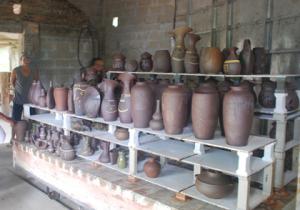A Glazed Look at Phuoc Tich Pottery

Phuoc Tich is a village about 40 kilometers north of Hue. And for over 500 years, it has been known for producing beautiful, world-class ceramics. Bowls, kettles, pots and jugs are the usual creations of the skilled pottery makers at Phuoc Tich. But established since 1470, the village has in fact been a part of the place’s history by having the opportunity to create pots and other items for not only one, but several palaces and kings of the Nguyen Dynasty.
In fact, these items are so historically significant that they are kept and displayed at the Hue Royal Fine Arts Museum. Le Trong Dien is an artisan who is lucky enough to own several hundred year old pottery items. In fact, one of his collections is a rice bowl particularly made for the royalty. Phuoc Tich pottery is so popular that the saying “Om Phuoc Tich ngon com hoang de” was conceived. It means “Phuoc Tich bowls made rice tasty to emperors.” It was local legend that during the Nguyen Dynasty, kings used two bowls everyday because it always broke after use.
Moreover, a king never ate from the same bowl twice. A former director of the Phuoc Tich Pottery Cooperative (who worked there for almost 30 years and can be said to have enough knowledge about the pottery in the place), remembers how in demand the pots were that as soon as they were brought out of the kiln, they were immediately sold. Boats all over the country came in all throughout the day to buy the high quality items. 12 kilns were needed and never seemed to rest creating the pots. Perhaps what makes Phuoc Tich pottery so famous is their material. Pots from the village is made of clay from the Dien Khanh region in the north central province of Qoang Tri, about 30 kilometers away from the area.
Aside from the high quality of the material, the clay is meticulously prepared before it is made into pottery items. Once molded into the desired shape, the item is baked at 1,200 OC, making it both strong and durable, the colors lasting. Le Ba Cang is a lecturer at the Hue University and has in fact been studying Phuoc Tich pottery for years. And based on her long and intensive study, it is the color in fact that sets Phuoc Tich pottery above the other pottery. Thus, quality material mixed with quality work equals high quality product strongly sought after and patronized by consumers.
But the war affected the business, as for all businesses, and for a long time, the kilns were not able to operate and produce pots. After the war ended in 1975, the Phuoc Tich Pottery Cooperative was established, operating until 1986. But after 1989, the pottery business at Phuoc Tich experienced a downfall. In 1995, the last kiln and pottery business closed down for good. In 2006, kilns were rebuilt to restore the historical trade. The first two batches of pottery items were displayed at the Hue Traditional Trade Festival in 2009. It was considered to be the resurrection of Phuoc Tich pottery.
In the same year, a joint project between the Hue University of Arts and the Phuoc Tich artisans produced 250 pottery products which are now on show at the Southern Culture Center in Hue. To ride with the present times, Puoc Tich artisans have expanded their work into making decorative pottery products as well. Thus, in addition to the traditional firewood kilns, gas kilns are now being installed. Other new products are also set to be introduced into the market, a mission and vision to bring back and carry forward the historical, wonderful and promising Phuoc Tich tradition of pottery.









